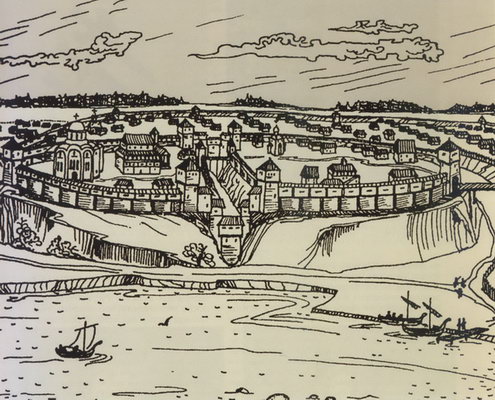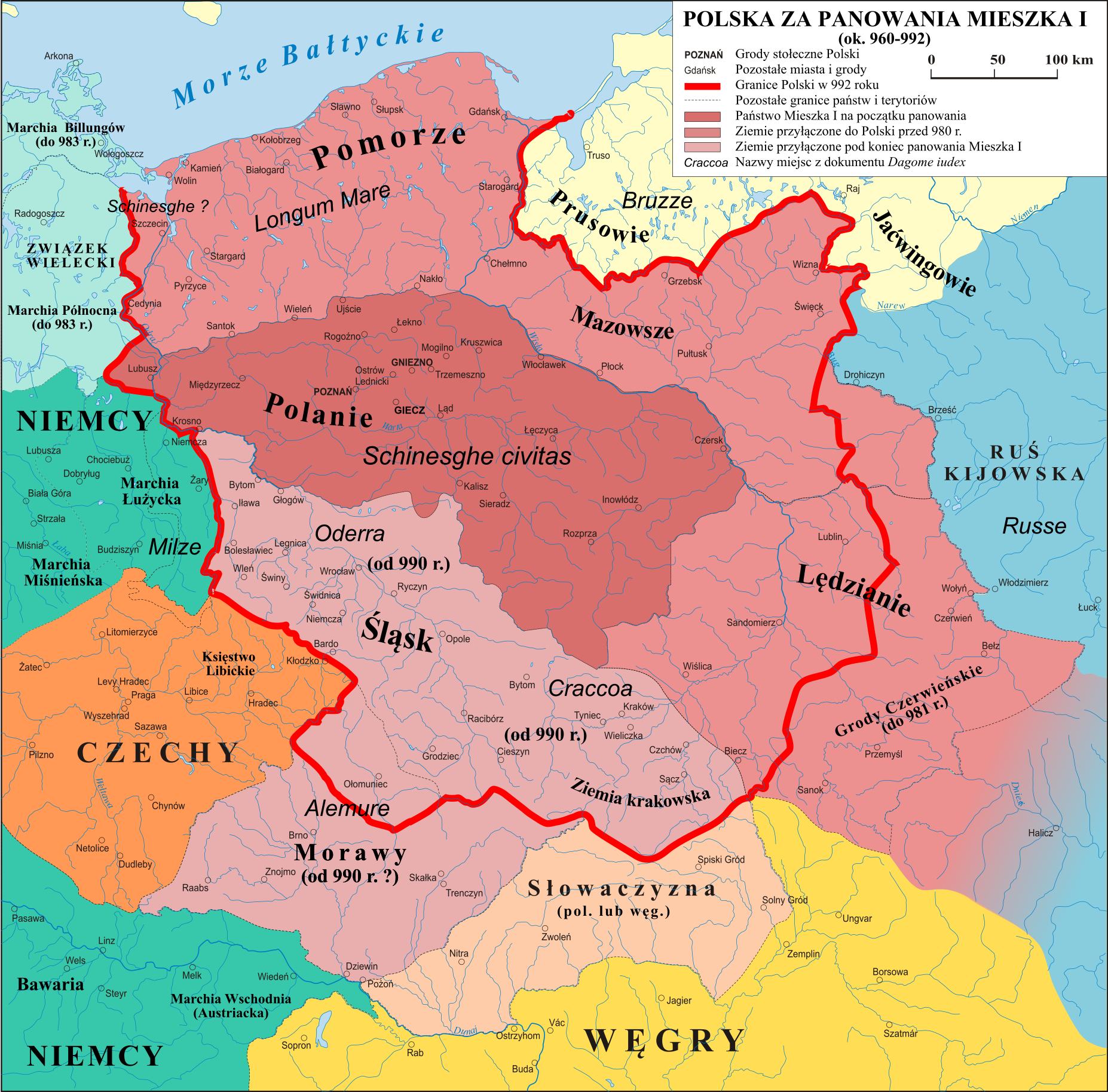|
Radimichs
The Radimichs (also Radimichi) ( be, Радзiмiчы, russian: Радимичи, uk, Радимичі and pl, Radymicze) were an East Slavic tribe of the last several centuries of the 1st millennium, which inhabited upper east parts of the Dnipro down the Sozh and its tributaries. The name probably derives from the name of the forefather of the tribe - Radim. According to Ruthenian chronicle tradition, "... but there were Radimichs from the Lechites family, who came and settled here and paid tribute to Rus, and the wagon was carried to the present day" (a ''wagon'' is a type of tax for the right to have one's own prince). However, in the scientific literature, there is no consensus on the ethnicity of the Radimichs. Archaeological evidence indicates that this tribal association had a mixed Slavic-Baltic origin. The Radimichs lived in the interfluve of the upper Dnipro and Desna rivers along the Sozh and its tributaries (the south of Vitebsk, the east of the Mogilev and Gome ... [...More Info...] [...Related Items...] OR: [Wikipedia] [Google] [Baidu] |
Gomel
Gomel (russian: Гомель, ) or Homiel ( be, Гомель, ) is the administrative centre of Gomel Region and the second-largest city in Belarus with 526,872 inhabitants (2015 census). Etymology There are at least six narratives of the origin of the city's name. The most plausible is that the name is derived from the name of the stream Homeyuk, which flowed into the river Sozh near the foot of the hill where the first settlement was founded. Names of other Belarusian cities are formed along these lines: for example, the name Minsk is derived from the river Menka, Polatsk from the river Palata, and Vitsebsk from the river Vitsba. The first appearance of the name, as "Gomy", dates from 1142. Up to the 16th century, the city was mentioned as Hom', Homye, Homiy, Homey, or Homyi. These forms are tentatively explained as derivatives of an unattested ''*gomŭ'' of uncertain meaning. The modern name for the city has been in use only since the 16th or 17th centuries. History Unde ... [...More Info...] [...Related Items...] OR: [Wikipedia] [Google] [Baidu] |
Vyatichi
The Vyatichs or more properly Vyatichi or Viatichi (russian: вя́тичи) were a native tribe of Early East Slavs who inhabited regions around the Oka, Moskva and Don rivers. The Vyatichi had for a long time no princes, but the social structure was characterized by democracy and self-government. Like various other Slavic tribes, the Vyatichi people built kurgans on territory which belongs now to the modern Russian state. The 12th-century ''Primary Chronicle'' recorded that the Vyatichi, Radimichs and Severians "had the same customs", all lived violent lifestyles, "burned their dead and preserved the ashes in urns set upon posts beside the highways", and they did not enter monogamous marriages but practiced polygamy, specifically polygyny, instead. The ''Primary Chronicle'' names a certain tribal leader Vyatko as the forefather of the tribe, who was a Lyakh brother of Radim from whom emerged the Radimichs. The Vyatichi were mainly engaged in farming and cattle-breeding. Betwe ... [...More Info...] [...Related Items...] OR: [Wikipedia] [Google] [Baidu] |
Homel
Gomel (russian: Гомель, ) or Homiel ( be, Гомель, ) is the administrative centre of Gomel Region and the second-largest city in Belarus with 526,872 inhabitants (2015 census). Etymology There are at least six narratives of the origin of the city's name. The most plausible is that the name is derived from the name of the stream Homeyuk, which flowed into the river Sozh near the foot of the hill where the first settlement was founded. Names of other Belarusian cities are formed along these lines: for example, the name Minsk is derived from the river Menka, Polatsk from the river Palata, and Vitsebsk from the river Vitsba. The first appearance of the name, as "Gomy", dates from 1142. Up to the 16th century, the city was mentioned as Hom', Homye, Homiy, Homey, or Homyi. These forms are tentatively explained as derivatives of an unattested ''*gomŭ'' of uncertain meaning. The modern name for the city has been in use only since the 16th or 17th centuries. History Unde ... [...More Info...] [...Related Items...] OR: [Wikipedia] [Google] [Baidu] |
Kievan Rus
Kievan Rusʹ, also known as Kyivan Rusʹ ( orv, , Rusĭ, or , , ; Old Norse: ''Garðaríki''), was a state in Eastern and Northern Europe from the late 9th to the mid-13th century.John Channon & Robert Hudson, ''Penguin Historical Atlas of Russia'' (Penguin, 1995), p.14–16.Kievan Rus Encyclopædia Britannica Online. Encompassing a variety of polities and peoples, including East Slavic, Norse, and Finnic, it was ruled by the , foun ... [...More Info...] [...Related Items...] OR: [Wikipedia] [Google] [Baidu] |
Smolensk
Smolensk ( rus, Смоленск, p=smɐˈlʲensk, a=smolensk_ru.ogg) is a city and the administrative center of Smolensk Oblast, Russia, located on the Dnieper River, west-southwest of Moscow. First mentioned in 863, it is one of the oldest cities in Russia. Population: The city has been destroyed several times throughout its long history because it was on the invasion routes of various empires. Smolensk is known for its electronics, textiles, food processing, and diamond faceting industries. Etymology The name of the city is derived from the name of the Smolnya River. Smolnya river flows through Karelian and Murmansk areas of north-western Russia. The origin of the river's name is less clear. One possibility is the old Slavic word () for black soil, which might have colored the waters of the Smolnya. An alternative origin could be the Russian word (), which means resin, tar, or pitch. Pine trees grow in the area, and the city was once a center of resin processing and t ... [...More Info...] [...Related Items...] OR: [Wikipedia] [Google] [Baidu] |
Vladimir The Great
Vladimir I Sviatoslavich or Volodymyr I Sviatoslavych ( orv, Володимѣръ Свѧтославичь, ''Volodiměrъ Svętoslavičь'';, ''Uladzimir'', russian: Владимир, ''Vladimir'', uk, Володимир, ''Volodymyr''. See Vladimir (name) for details., ''Vladimir Svyatoslavich''; uk, Володимир Святославич, ''Volodymyr Sviatoslavych''; Old Norse ''Valdamarr gamli''; c. 95815 July 1015), also known as Vladimir the Great or Volodymyr the Great, was Prince of Novgorod, Grand Prince of Kiev, and ruler of Kievan Rus' from 980 to 1015. Vladimir's father was Prince Sviatoslav I of Kiev of the Rurikid dynasty. After the death of his father in 972, Vladimir, who was then prince of Novgorod, was forced to flee to Scandinavia in 976 after his brother Yaropolk murdered his other brother Oleg of Drelinia, becoming the sole ruler of Rus'. In Sweden, with the help of his relative Ladejarl Håkon Sigurdsson, ruler of Norway, he assembled a Varangian ... [...More Info...] [...Related Items...] OR: [Wikipedia] [Google] [Baidu] |
Chechersk
Chachersk ( be, Чачэрск, , russian: Чечерск, pl, Czeczersk) is a city in the Gomel Region of Belarus, an administrative center of the Chachersk District. It is located in an area which was highly contaminated due to the fallout of the Chernobyl disaster. History The town was founded in the late 10th century on the Sozh River. It was first mentioned in chronicles in 1159 as the city Radimichi Chachersk. Sometime later a castle was built in the area. From 14th century to 1772, Chachersk was part of the Grand Duchy of Lithuania, which was part of the Polish–Lithuanian Commonwealth from 1569. In 1772, it became part of the Russian Empire, as the center of the county in the province Rahachow, then borough, and parish center of Rogachev district. In 1774, Catherine II of Russia in collaboration with a local governor helped build the town hall, churches, a theater, 2 hospitals, and other notable buildings. Redevelopment of the city took place, with the destruction of ... [...More Info...] [...Related Items...] OR: [Wikipedia] [Google] [Baidu] |
Lechites
Lechites (, german: Lechiten), also known as the Lechitic tribes (, german: Lechitische Stämme), is a name given to certain West Slavic tribes who inhabited modern-day Poland and eastern Germany, and were speakers of the Lechitic languages. Distinct from the Czech–Slovak subgroup, they are the closest ancestors of ethnic Poles and the Pomeranians, Lusatians and Polabians. History According to Polish legend, Mieszko I inherited the ducal throne from his father who probably ruled over two-thirds of the territory inhabited by eastern Lechite tribes. He united the Lechites east of the Oder (Polans, Masovians, Pomeranians, Vistulans, Silesians) into a single country of Poland. His son, Bolesław I the Brave, founded the bishoprics at Wrocław, Kołobrzeg, and Kraków, and an archbishopric at Gniezno. Bolesław carried out successful wars against Bohemia, Moravia, Kievan Rus' and Lusatia, and forced the western Pomeranians to pay Poland a tribute. Shortly before his death Bo ... [...More Info...] [...Related Items...] OR: [Wikipedia] [Google] [Baidu] |
Lendians
The Lendians ( pl, Lędzianie) were a Lechitic tribe who lived in the area of East Lesser Poland and Cherven Cities between the 7th and 11th centuries. Since they were documented primarily by foreign authors whose knowledge of Central and East Europe geography was often vague, they were recorded by different names, which include ''Lendzanenoi'', ''Lendzaninoi'', ''Lz’njn'', ''Lachy'', ''Lyakhs'', ''Landzaneh'', ''Lendizi'', ''Licicaviki'' and ''Litziki''. Name The name "Lędzianie" (*lęd-jan-inъ) derives from the Proto-Slavic and Old Polish word "lęda", meaning "field". In modern Polish, the word "ląd" means "land". The Lędzianie tribe's name comes from their use of slash-and-burn agriculture, which involved cutting and burning of forests or woodlands to create fields. Accordingly, in this meaning Lendians were woodland-burning farmers, or "inhabitants of fields". Several European nations source their ethnonym for Poles, and hence Poland, from the name of Lendians: Lit ... [...More Info...] [...Related Items...] OR: [Wikipedia] [Google] [Baidu] |
Nestor The Chronicler
Saint Nestor the Chronicler ( orv, Несторъ Лѣтописецъ; 1056 – c. 1114, in Principality of Kiev, Kievan Rus') was the reputed author of ''Primary Chronicle'' (the earliest East Slavic letopis), ''Life of the Venerable Theodosius of the Kiev Caves'' and ''Account about the Life and Martyrdom of the Blessed Passion Bearers Boris and Gleb.'' Biography In 1073 AD, Nestor became a monk of the Monastery of the Caves in Kiev. The only other detail of his life that is reliably known is that he was commissioned with two other monks to find the relics of St. Theodosius of Kiev, a mission which he fulfilled successfully. It is also speculated that he supported the reigning prince Svyatopolk II, and his pro- Slavic party disliked Greek influence in Kiev. His chronicle begins with the Deluge, as did those of most Christian chroniclers of the time. The compiler appears to have been acquainted with the Byzantine historians; he makes use especially of John Malalas and ... [...More Info...] [...Related Items...] OR: [Wikipedia] [Google] [Baidu] |
Ethnic
An ethnic group or an ethnicity is a grouping of people who identify with each other on the basis of shared attributes that distinguish them from other groups. Those attributes can include common sets of traditions, ancestry, language, history, society, culture, nation, religion, or social treatment within their residing area. The term ethnicity is often times used interchangeably with the term nation, particularly in cases of ethnic nationalism, and is separate from the related concept of races. Ethnicity may be construed as an inherited or as a societally imposed construct. Ethnic membership tends to be defined by a shared cultural heritage, ancestry, origin myth, history, homeland, language, or dialect, symbolic systems such as religion, mythology and ritual, cuisine, dressing style, art, or physical appearance. Ethnic groups may share a narrow or broad spectrum of genetic ancestry, depending on group identification, with many groups having mixed genetic ancestry. Ethnic gr ... [...More Info...] [...Related Items...] OR: [Wikipedia] [Google] [Baidu] |
.jpg)






